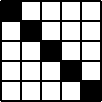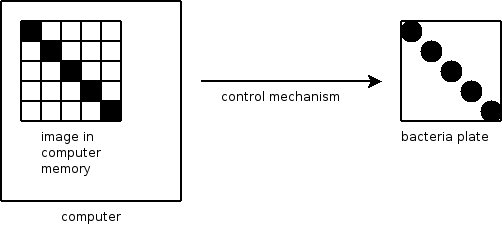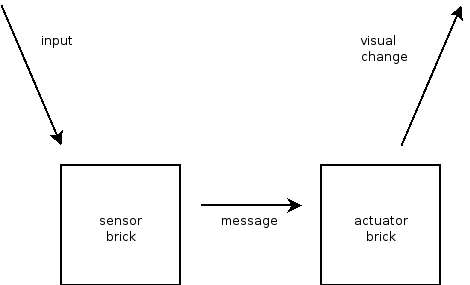Architectural Overview
Overview
The aim of the display is to show content that is generated by a computer. In this regard, the display is similar to traditional computer displays.
Computer displays work on a grid array, with each point in the array called a pixel. The image is approximated by the pixels themselves. For example, here is a diagonal line on a 5×5 pixel display:

The aim of the project is to create a similar result, where the pixels are made out of living bacteria.
Architecture
The basic architecture of the display is that there’s an image intended to be displayed in the computer memory. The computer then uses some control mechanism to change the properties of the bacteria plate so that it resembles the image to be displayed.
Bacteria pixels
The control mechanism involved has to convert the grid information in the computer to a visible change in bacteria. The following approaches all achieve the this effect, using different approaches.
Chemically triggered alternative
If the pixel has to be in ‘off’ state, then no chemicals would be added to the bacteria:
If the pixel is to be in ‘on’ state, then the chemicals added trigger a change in the visual properties of the bacteria:
It is assumed that the withdrawing the chemical will revert the bacteria into its original (‘off’) state.
Pros of this approach:
- probably easy to implement
Cons of this approach:
- probably slow response time
- each pixel requires a valve, which raises scaling issues. a 20×20 pixel display would already require 400 valves
- better is to use inkjet printer technology instead of valves
Open issues:
- would the chemicals accumulate over time, and thus force the pixels to be always on? (similar to the burn-in effect in CRTs)
Light-triggered alternative
In this approach, the change in bacteria is triggered by an external light source. Typically this would be of a wavelenght that is not visible to the human eye.
If external light hits the bacteria, it turns ‘on’:
If there is no external light, the bacteria is ‘off’:
Pros of this approach:
- probably easy to implement
- probably fast response time
- controlling LEDs is straightforward
Cons of this approach:
- a conceptual issue: basically there are two displays, the human invisible light triggers, and the bacteria display – sort of makes the bacteria display concept questionable
Open issues:
Bio-brick implementation
Using a bio-brick approach, one could implement all of the above functionality using two bricks:
- a sensor brick, that gets activated based on the external chemical input, and sends a message to the actuator brick
- an actuator brick, that when receives the message generated by the sensor, activates the visual change



April 16th, 2010 at 8:42 am
[…] Architectural Overview […]